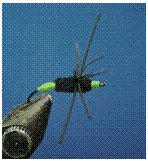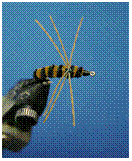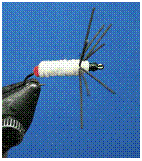SPRINGTIME BREAM FISHING
Bream, sunfish or panfish – call them what you want, they are the same group of thirty species of fun catching, good eating fish. We all know it was a hard winter and the bass and bream have been practically comatose. Lately, the thermometer has been playing yo-yo, one bright warm day followed by two or three overcast humid chillers that qualify as simply miserable. Then windy rainy days, perfect for putting a knot in your loop. Happily, it can’t be long before nighttime temperatures near 60, waterbodies will warm quickly and spring can’t be far behind. When it happens, there should be a sign on every lake that reads “Want bluegills?”
Desormeaux was in jail and received a letter from his wife. She wrote: “Now that Spring is here, I have decided to plant vegetables in the back garden. When is the best time to plant them?”
Desormeaux, was sure Sheriff Breaux read all the mail, so he replied in a letter: “Whatever you do, DO NOT touch the back garden! That is where I hid all the gold.”
A week or so later, he received another letter from his wife: “You wouldn't believe what happened. Some deputies came and dug up the whole back garden.”
Desormeaux wrote back: “NOW is the best time to plant!”
Springtime bream fishing is not measured by the date, it is determined by the water temperature. Once warm weather arrives, usually April, most sunfish move into the shallows to spawn. Surface temperatures of the water need to be in the 70s (subsurface 65ish) for spawning, but you don’t have to carry around a thermometer. When the edge of your favorite lake looks like the surface of the moon, the spawn has begun.
Each male builds and defends its own nest, and usually several males have their nests in close proximity, sometimes only a foot or so apart so that the shallows appear to be pocked marked. An average bream lives five years and begins spawning after one. Males approach the shallows first and while spawning can take place in open water, it usually happens near vegetation, tree roots, and tree shade. Males build nesting colonies in and will guard the eggs and newly hatched fry and reach the swimming stage. Eggs take about a week to hatch and fry stay around the nest for another week.


You need to know about spawning time because you want to catch the spawning fish. Don’t worry about affecting the sunfish population, at an average of 18,000 fry hatching from each bed, it is almost impossible to over fish them. Males want to have the most centrally located nests where they have the greatest chance of fertilizing the most eggs. [A centrally located nesting bed could get more than 50,000 eggs while perimeter beds have considerably less.] Males are very protective will aggressively defend the nest from predators and females.
Fry eat algae and zooplankton. As they grow larger, a bream’s menu adds small fish, aquatic insects and more plant matter to their diet. Males expend considerable energy during the spawn and feed voraciously whenever possible, but always near the nest. Females also show increased hunger during this period, and are especially aggressive after eggs have been laid. For this reason, spawning bream are easy to catch and attack a wide variety of offerings.
The first and best thing about spring bream fishing is that you can practically catch them on anything from a prize winning replica stonefly to a safety pin dressed with a dust bunny. Any fly dropped near a spawning area is going to get a bream’s attention and be attacked. Dry flies shouldn’t be too big, but an attractive dry fly or popper will draw continual strikes from hungry bluegill, perhaps as many as three or four on a cast.
The second and almost best thing about spring bream fishing is that the weather is usually beautiful. Surface temperatures for the fisherman don’t usually get above the low 80s and, since you will fish a lot near dusk, they will likely be cooler. Of course there is the issue of the mosquitos, but if you haven’t discovered “Bug Off” clothing...you should.
The next best, and maybe the very best thing about spring fishing is that panfish are delicious.
A Wildlife & Fisheries agent was making rounds in a remote part of a game management area when he came across Jud, sitting at a make-shift campfire. On a spit over the fire were the remains of a roasted bald eagle. The agent arrested Jud and soon they were before the judge.
“Do you know that harassing a bald eagle is a federal offense?” the Judge asked.
“I didn’t harass him,” Jud said. “I killed him. But it was on accident.”
“Accident?”
“Yessir. I can explain.”
“This I’ve got to hear,” the Judge said.
“Well, it was like this. I got lost about two weeks back, and I was near to starving. I’d been trying to catch a fish for dinner when this eagle comes and snatches up a good old biggun’ from the lake and sits down on a stump to eat it. I chucked a rock at the eagle to scare it off so I could take the fish and, wouldn’t you know, that rock killed the bird dead. Since I was still hungry, and the bird wasn’t going anywhere, I figured I might as well eat it as let it rot.”
After some consideration, the judge said: “Due to the unusual circumstances, I am going to dismiss the charges against you.” Jud was all smiles. The Judge then leaned over the bench and whispered: “If you don't mind my asking, what does a bald eagle taste like?”
“Well, Judge, it’s hard to explain. The best I can describe, it’s better than panda but not so good as spotted owl.”
Of course, as easy as fishing the spawn is, there are techniques to make your fly fishing experience better. Here are a few ideas.
1. If you don’t see sunfish beds, look for likely spots. Concentrate on shallows, roots or stumps. If you can see the beds, fish there. Waters adjacent to weeds are excellent choices. Drag the fly parallel to the weeds as close as you can manage (getting hung up occasionally is an occupational risk). Waters around cypress or willow roots are good. Drag the flies right over and through the roots. Waters below hanging branches can be spectacular. Learning to deliver a fly under the branch may take practice but is well worth the trouble. A few inches from the bank may be the best zone to get bites.
2. Fish tandem/dropper rigs. You can catch plenty of bream on a single fly, but fishing a dry with a dropper is always the better option. Because strikes can be subtle (although most are vicious) a dry fly can serve the purpose of a strike indicator. Be totally focused and watch the connection between your fly line and leader for a twitch. Of course, seeing a foam beetle move backwards is always a telltale.
3. Choose bright colors and florescents for topwater patterns. Combine contrasting colors on flies as bream see these best.
4. Fish soft hackles or rubber legged nymphs alone, in tandem or as droppers. The motion of the legs is often irresistible to bream.
5. Experiment with hook sizes. Sometimes a 6 is too big or a 14 only attracts small fish.
6. Make your ultimate target the center of the nest of beds. Cast first just short of your target and retrieve, then work up to the target.
7. Pop and stop. If you wonder why you sometimes get a hookup just as you are readying to backcast, it is because you unconsciously pause the fly as you start back. Bream frequently attack a still fly or one on the drop.
8. Move your fly around. Even if you are standing in one place, fan cast around you so that you are not machine-gunning one location. You may have spooked the bream and they will take a moment to return.



Here is my favorite spring bream pattern.
The Spring Standard
- Hook: Standard round bend nymph hook sizes 8 to 14.
- Thread: Danville Flat Waxed Nylon
- Body: ultra chenille
- Underbody: 10-12 wraps of (.15) lead wire
- Legs: silicon skirting or rubber legs
1. Lay a layer of thread along the hook shank.
2. Wrap 10-12 turns of lead wire on thread in the middle of the shank, keeping wraps snug one against the other.
3. Overwrap lead with thread until secure.
4. Tie in chenille at the back of the lead wrap and wrap thread over the chenille to the bend of the shank.
5. Bring thread to front of lead wraps and tie in legs using a figure eight pattern.
6. Wrap chenille so that the chenille turns hold the legs snugly
7. Make one or two wraps in front of legs.
9. Tie down chenille and cut.
10. Make a small thread head (the head is not important as long as it is neat and small) and whip finish.
11. Coat head with Sally Hansen’s Hard As Nails.
Panfishing is usually NOT catch and release. Here’s a good recipe.
FRYING PANFISH
- 20 headless fish, scaled and gutted
- 3 Tbs. yellow mustard
- 2 Tbs. lemon juice
- 1 tsp. Worcestershire sauce
- 2 tsp. Louisiana hot sauce (Tabasco, Louisiana Gold or Crystal)
- 1 Tbs. juice from a jar of dill pickles
- 1 cup corn meal
- 1 cup corn flour (Zatarain’s Fish-Fri)
- 1 Tbs. salt
- ½ tsp. granulated garlic
- ½ tsp. Cajun seasoning or red pepper
- Peanut oil for frying at 375 degrees
1. Prepare bream by scaling, removing the head behind the gills and all entrails.
2. Blend the mustard, lemon juice, Worcestershire, hot sauce and pickle juice in a large bowl. Put the bream into the bowl toss them to coat with the marinade. Allow fish to marinate for about a half hour, refrigerated
3. In a large, rounded bowl, combine the corn flour, corn meal, salt, Cajun seasoning and granulated garlic with a fork. Put four to six bream in the bowl and coat with the mixture.
4. Heat the oil to 375 degrees. When it's ready, put five or six fish in and cook to golden brown. Remove and drain on paper towels.
The flesh and skin of the bream are edible, but be careful of small bones. Most folks consider the fins and tail to be a delicacy.
